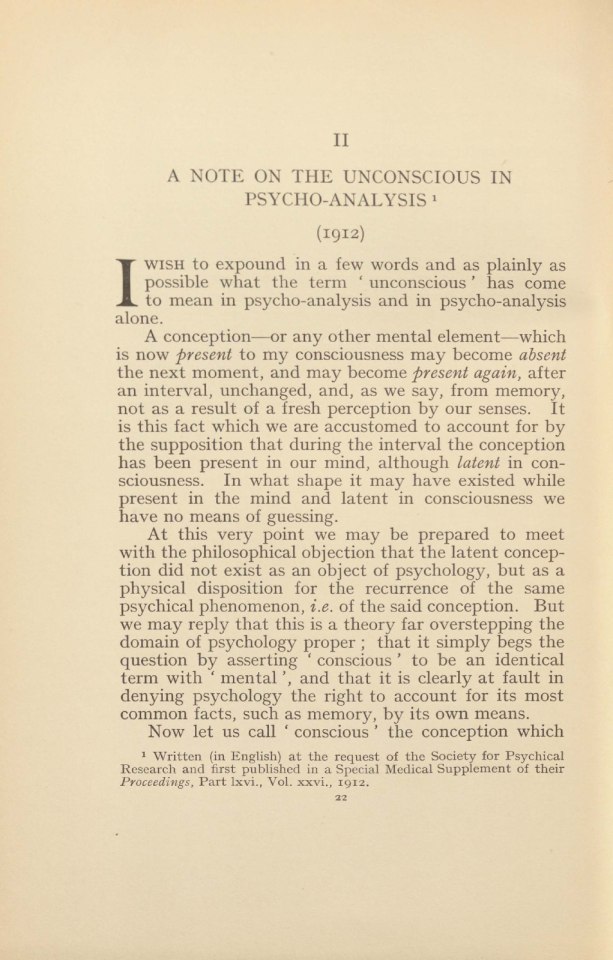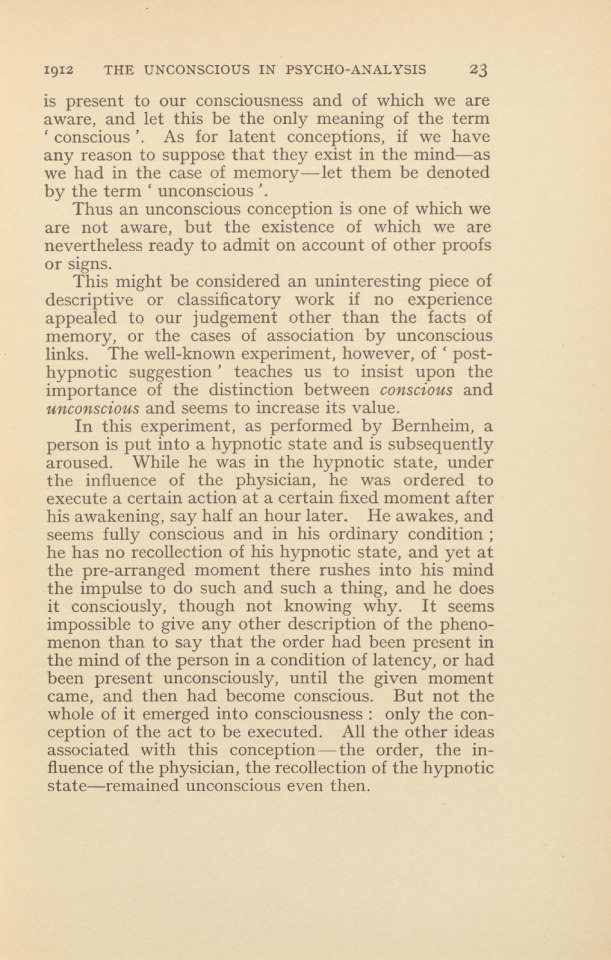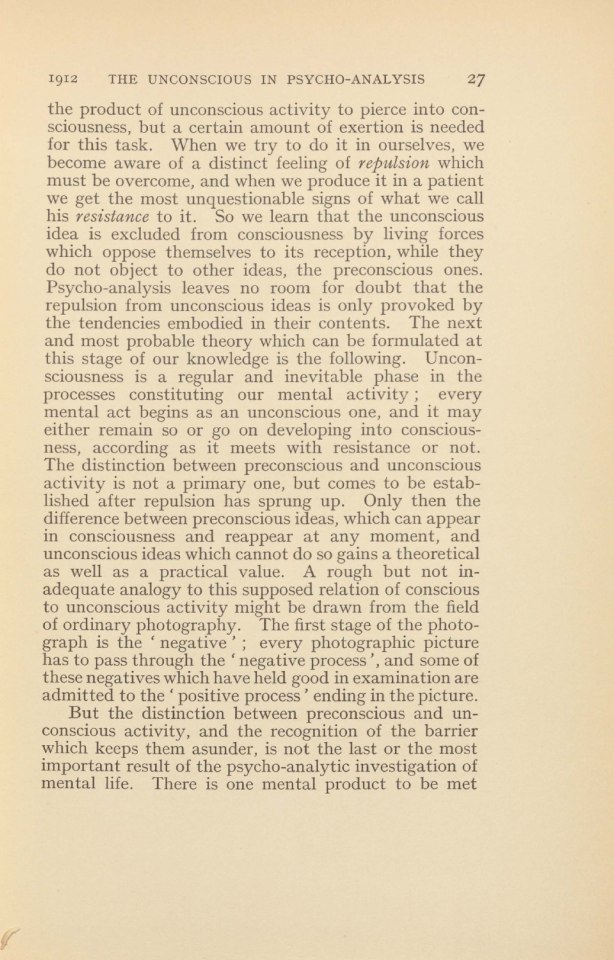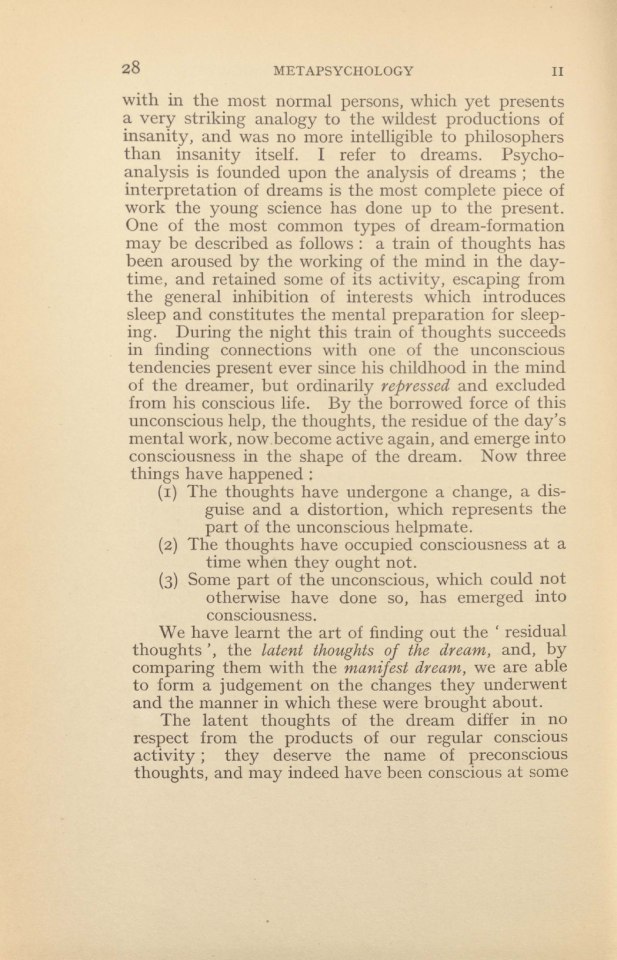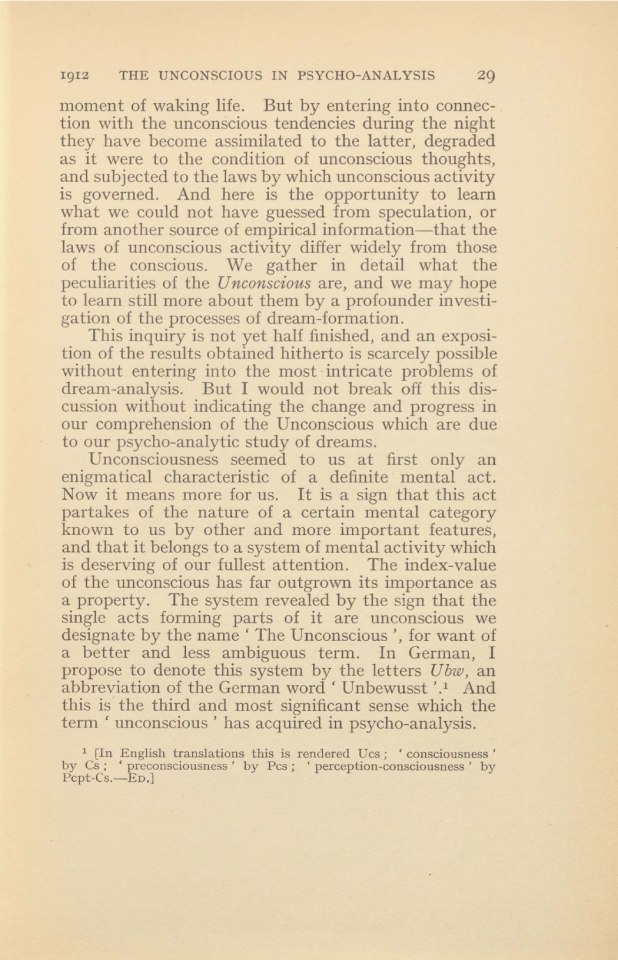S.
11
A NOTE ON THE UNCONSCIOUS IN
PSYCHO-ANALYSIS 1(1912)
WISH to expound in a few words and as plainly as
1 possible what the term ‘unconscious’ has cometo mean in psycho-analysis and in psycho-analysis
alone.A conception—or any other mental element—which
is now present to my consciousness may become absent
the next moment, and may become present again, after
an interval, unchanged, and, as we say, from memory,
not as a result of a fresh perception by our senses. It
is this fact which we are accustomed to account for by
the supposition that during the interval the conception
has been present in our mind, although latent in con-
sciousness. In what shape it may have existed while
present in the mind and latent in consciousness we
have no means of guessing.At this very point we may be prepared to meet
with the philosophical objection that the latent concep-
tion did not exist as an object of psychology, but as a
physical disposition for the recurrence of the same
psychical phenomenon, 7.0. of the said conception. But
we may reply that this is a theory far overstepping the
domain of psychology proper ; that it simply begs the
question by asserting ‘ conscious’ to be an identical
term with ‘ mental’, and that it is clearly at fault in
denying psychology the right to account for its most
common facts, such as memory, by its own means.Now let us call ` conscious’ the conception which
1 Written (in English) at the request of the Society for Psychical
Research and first published in a Special Medical Supplement of theirProceedings, Part Ixvi., Vol. xxvi., 1912.
22S.
1912 THE UNCONSCIOUS IN PSYCHO-ANALYSIS 23
is present to our consciousness and of which we are
aware, and let this be the only meaning of the term
* conscious’. As for latent conceptions, if we have
any reason to suppose that they exist in the mind—as
we had in the case of memory—let them be denoted
by the term ` unconscious '.Thus an unconscious conception is one of which we
are not aware, but the existence of which we are
nevertheless ready to admit on account of other proofs
or signs.This might be considered an uninteresting piece of
descriptive or classificatory work if no experience
appealed to our judgement other than the facts of
memory, or the cases of association by unconscious
links. The well-known experiment, however, of ‘ post-
hypnotic suggestion’ teaches us to insist upon the
importance of the distinction between conscious and
unconscious and seems to increase its value.In this experiment, as performed by Bernheim, a
person is put into a hypnotic state and is subsequently
aroused. While he was in the hypnotic state, under
the influence of the physician, he was ordered to
execute a certain action at a certain fixed moment after
his awakening, say half an hour later. He awakes, and
seems fully conscious and in his ordinary condition ;
he has no recollection of his hypnotic state, and yet at
the pre-arranged moment there rushes into his mind
the impulse to do such and such a thing, and he does
it consciously, though not knowing why. It seems
impossible to give any other description of the pheno-
menon than to say that the order had been present in
the mind of the person in a condition of latency, or had
been present unconsciously, until the given moment
came, and then had become conscious. But not the
whole of it emerged into consciousness : only the con-
ception of the act to be executed. All the other ideas
associated with this conception— the order, the in-
fluence of the physician, the recollection of the hypnotic
state—remained unconscious even then.S.
24 METAPSYCHOLOGY II
But we have more to learn from such an experi-
ment. We are led from the purely descriptive to a
dynamic view of the phenomenon. The idea of the
action ordered in hypnosis not only became an object
of consciousness at a certain moment, but the more
striking aspect of the fact is that this idea grew active :
it was translated into action as soon as consciousness
became aware of its presence. The real stimulus to
the action being the order of the physician, it is hard
not to concede that the idea of the physician’s order
became active too. Yet this last idea did not reveal
itself to consciousness, as did its outcome, the idea of
the action; it remained unconscious, and so it was
active and unconscious at the same time.A post-hypnotic suggestion is a laboratory produc-
tion, an artificial fact. But if we adopt the theory of
hysterical phenomena first put forward by Pierre Janet
and elaborated by Breuer and myself, we shall not be
at a loss for plenty of natural facts showing the psycho-
logical character of the post-hypnotic suggestion even
more clearly and distinctly.The mind of the hysterical patient is full of active
yet unconscious ideas ; all her symptoms proceed from
such ideas. It is in fact the most striking character
of the hysterical mind to be ruled by them. If the
hysterical woman vomits, she may do so from the idea
of being pregnant. She has, however, no knowledge
of this idea, although it can easily be detected in her
mind, and made conscious to her, by one of the
technical procedures of psycho-analysis. If she is
executing the jerks and movements constituting her
* fit ’, she does not even consciously represent to herself
the intended actions, and she may perceive those actions
with the detached feelings of an onlooker. Neverthe-
less analysis will show that she was acting her part
in the dramatic reproduction of some incident in her
life, the memory of which was unconsciously active
during the attack. The same preponderance of active
unconscious ideas is revealed by analysis as theS.
1912 THE UNCONSCIOUS IN PSYCHO-ANALYSIS 25
essential fact in the psychology of all other forms of
neurosis.We learn therefore by the analysis of neurotic
phenomena that a latent or unconscious idea is not
necessarily a weak one, and that the presence of such
an idea in the mind admits of indirect proofs of the most
cogent kind, which are equivalent to the direct proof
furnished by consciousness. We feel justified in making
our classification agree with this addition to our know-
ledge by introducing a fundamental distinction between
different kinds of latent or unconscious ideas. We
were accustomed to think that every latent idea was so
because it was weak and that it grew conscious as soon
as it became strong. We have now gained the convic-
tion that there are some latent ideas which do not
penetrate into consciousness, however strong they may
have become. Therefore we may call the latent ideas
of the first type preconscious, while we reserve the
term unconscious (proper) for the latter type which we
came to study in the neuroses. The term unconscious,
which was used in the purely descriptive sense before,
now comes to imply something more. It designates
not only latent ideas in general, but especially ideas
with a certain dynamic character, ideas keeping apart
from consciousness in spite of their intensity and
activity.Before continuing my exposition I will refer to two
objections which are likely to be raised at this point.
The first of these may be stated thus : instead of sub-
scribing to the hypothesis of unconscious ideas of which
we know nothing, we had better assume that conscious-
ness can be split up, so that certain ideas or other
psychical acts may constitute a consciousness apart,
which has become detached and estranged from the bulk
of conscious psychical activity. Well-known patho-
logical cases like that of Dr. Azam seem to go far to
show that the splitting up of consciousness is no
fanciful imagination.I venture to urge against this theory that it is a
S.
26 METAPSYCHOLOGY II
gratuitous assumption, based on the abuse of the word
* conscious ’. We have no right to extend the meaning
of this word so far as to make it include a consciousness
of which its owner himself is not aware. If philosophers
find difficulty in accepting the existence of unconscious
ideas, the existence of an unconscious consciousness
seems to me even more objectionable. The cases
described as splitting of consciousness, like Dr. Azam's,
might better be denoted as shifting of consciousness,—
that function—or whatever it be—oscillating between
two different psychical complexes which become con-
scious and unconscious in alternation.The other objection that may probably be raised
would be that we apply to normal psychology con-
clusions which are drawn chiefly from the study of
pathological conditions. We are enabled to answer it
by another fact, the knowledge of which we owe to
psycho-analysis. Certain deficiencies of function of
most frequent occurrence among healthy people, e.g.
lapsus linguae, errors in memory and speech, forgetting
of names, etc., may easily be shown to depend on the
action of strong unconscious ideas in the same way as
neurotic symptoms. We shall meet with another still
more convincing argument at a later stage of this
discussion.By the differentiation of preconscious and un-
conscious ideas, we are led on to leave the field of
classification and to form an opinion about functional
and dynamical relations in the action of the mind. We
have found a preconscious activity passing into con-
sciousness with no difficulty, and an unconscious
activity which remains so and seems to be cut off from
consciousness.Now we do not know whether these two modes of
psychical activity are identical or essentially divergent
from their beginning, but we may ask why they should
become different in the course of mental action. To
this last question psycho-analysis gives a clear and
unhesitating answer. It is by no means impossible forS.
1912 THE UNCONSCIOUS IN PSYCHO-ANALYSIS 27
the product of unconscious activity to pierce into con-
sciousness, but a certain amount of exertion is needed
for this task. When we try to do it in ourselves, we
become aware of a distinct feeling of repulsion which
must be overcome, and when we produce it in a patient
we get the most unquestionable signs of what we call
his resistance to it. So we learn that the unconscious
idea is excluded from consciousness by living forces
which oppose themselves to its reception, while they
do not object to other ideas, the preconscious ones.
Psycho-analysis leaves no room for doubt that the
repulsion from unconscious ideas is only provoked by
the tendencies embodied in their contents. The next
and most probable theory which can be formulated at
this stage of our knowledge is the following. Uncon-
sciousness is a regular and inevitable phase in the
processes constituting our mental activity; every
mental act begins as an unconscious one, and it may
either remain so or go on developing into conscious-
ness, according as it meets with resistance or not.
The distinction between preconscious and unconscious
activity is not a primary one, but comes to be estab-
lished after repulsion has sprung up. Only then the
difference between preconscious ideas, which can appear
in consciousness and reappear at any moment, and
unconscious ideas which cannot do so gains a theoretical
as well as a practical value. A rough but not in-
adequate analogy to this supposed relation of conscious
to unconscious activity might be drawn from the field
of ordinary photography. The first stage of the photo-
graph is the ‘negative’; every photographic picture
has to pass through the ‘ negative process’, and some of
these negatives which have held good in examination are
admitted to the ` positive process’ ending in the picture.But the distinction between preconscious and un-
conscious activity, and the recognition of the barrier
which keeps them asunder, is not the last or the most
important result of the psycho-analytic investigation of
mental life. There is one mental product to be metS.
28 METAPSYCHOLOGY 11
with in the most normal persons, which yet presents
a very striking analogy to the wildest productions of
insanity, and was no more intelligible to philosophers
than insanity itself. I refer to dreams. Psycho-
analysis is founded upon the analysis of dreams ; the
interpretation of dreams is the most complete piece of
work the young science has done up to the present.
One of the most common types of dream-formation
may be described as follows : a train of thoughts has
been aroused by the working of the mind in the day-
time, and retained some of its activity, escaping from
the general inhibition of interests which introduces
sleep and constitutes the mental preparation for sleep-
ing. During the night this train of thoughts succeeds
in finding connections with one of the unconscious
tendencies present ever since his childhood in the mind
of the dreamer, but ordinarily repressed and excluded
from his conscious life. By the borrowed force of this
unconscious help, the thoughts, the residue of the day’s
mental work, now become active again, and emerge into
consciousness in the shape of the dream. Now three
things have happened :(1) The thoughts have undergone a change, a dis-
guise and a distortion, which represents the
part of the unconscious helpmate.(2) The thoughts have occupied consciousness at a
time when they ought not.(3) Some part of the unconscious, which could not
otherwise have done so, has emerged into
consciousness.We have learnt the art of finding out the ‘ residual
thoughts”, the latent thoughts of the dream, and, by
comparing them with the manifest dream, we are able
to form a judgement on the changes they underwent
and the manner in which these were brought about.The latent thoughts of the dream differ in no
respect from the products of our regular conscious
activity ; they deserve the name of preconscious
thoughts, and may indeed have been conscious at someS.
1912 THE UNCONSCIOUS IN PSYCHO-ANALYSIS 29
moment of waking life. But by entering into connec-
tion with the unconscious tendencies during the night
they have become assimilated to the latter, degraded
as it were to the condition of unconscious thoughts,
and subjected to the laws by which unconscious activity
is governed. And here is the opportunity to learn
what we could not have guessed from speculation, or
from another source of empirical information—that the
laws of unconscious activity differ widely from those
of the conscious. We gather in detail what the
peculiarities of the Unconscious are, and we may hope
to learn still more about them by a profounder investi-
gation of the processes of dream-formation.This inquiry is not yet half finished, and an exposi-
tion of the results obtained hitherto is scarcely possible
without entering into the most intricate problems of
dream-analysis. But I would not break off this dis-
cussion without indicating the change and progress in
our comprehension of the Unconscious which are due
to our psycho-analytic study of dreams.Unconsciousness seemed to us at first only an
enigmatical characteristic of a definite mental act.
Now it means more for us. It is a sign that this act
partakes of the nature of a certain mental category
known to us by other and more important features,
and that it belongs to a system of mental activity which
is deserving of our fullest attention. The index-value
of the unconscious has far outgrown its importance as
a property. The system revealed by the sign that the
single acts forming parts of it are unconscious we
designate by the name ‘ The Unconscious ', for want of
a better and less ambiguous term. In German, I
propose to denote this system by the letters Ubw, an
abbreviation of the German word ' Unbewusst '.! And
this is the third and most significant sense which the
term ‘ unconscious ` has acquired in psycho-analysis.1 [In English translations this is rendered Ucs; ` consciousness `
by Cs; ` preconsciousness ” by Pcs; ` perception-consciousness ` by
Pept-Cs.—Ep.]
freud-1925-cp-5
22
–29
